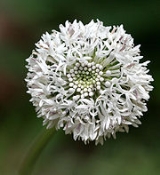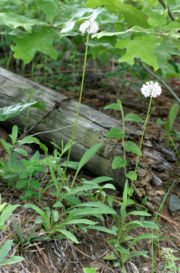
Marshallia
Encyclopedia

Asteraceae
The Asteraceae or Compositae , is an exceedingly large and widespread family of vascular plants. The group has more than 22,750 currently accepted species, spread across 1620 genera and 12 subfamilies...
, endemic to the southeastern United States
United States
The United States of America is a federal constitutional republic comprising fifty states and a federal district...
. A common name applied to most species in the genus is Barbara's Buttons. There are seven species, all perennials
Perennial plant
A perennial plant or simply perennial is a plant that lives for more than two years. The term is often used to differentiate a plant from shorter lived annuals and biennials. The term is sometimes misused by commercial gardeners or horticulturalists to describe only herbaceous perennials...
. The small white-to-pinkish flowers occur in large, compact, spherical heads. Marshallia is found in open habitats, such as roadsides, bogs, or open woodlands dominated by pine
Pine
Pines are trees in the genus Pinus ,in the family Pinaceae. They make up the monotypic subfamily Pinoideae. There are about 115 species of pine, although different authorities accept between 105 and 125 species.-Etymology:...
s. Several species are associated with wetlands. The typical blooming period is late spring (May) and early summer (June or early July). Marshallia are very attractive to pollinating insects, including butterflies
Butterfly
A butterfly is a mainly day-flying insect of the order Lepidoptera, which includes the butterflies and moths. Like other holometabolous insects, the butterfly's life cycle consists of four parts: egg, larva, pupa and adult. Most species are diurnal. Butterflies have large, often brightly coloured...
and various beetle
Beetle
Coleoptera is an order of insects commonly called beetles. The word "coleoptera" is from the Greek , koleos, "sheath"; and , pteron, "wing", thus "sheathed wing". Coleoptera contains more species than any other order, constituting almost 25% of all known life-forms...
s, such as flower chafers of the genus Euphoria
Euphoria (beetle)
Euphoria is a genus of New World scarab beetles in the subfamily Cetoniinae, the flower chafers. It is estimated that there are 20-29 species of the genus Euphoria in North America. These beetles are diurnal, and visit flowers to obtain pollen and/or nectar...
(Coin 2005). The genus was named for botanist Humphry Marshall
Humphry Marshall
Humphry Marshall was an American botanist and plant dealer.-Biography:Humphry Marshall was born in the village of Marshallton, Pennsylvania on October 10, 1722. He was the cousin of botanist John Bartram and William Bartram...
.
Species
- Marshallia caespitosa Nutt. ex DC., Puffballs
- Marshallia graminifolia (Walt.) Small, Grassleaf Barbara's buttons
- Marshallia grandifloraMarshallia grandifloraMarshallia grandiflora is a genus of flowering plants in the family, Asteraceae. It's a Species of Concern with the largest population in the world occurring in West Virginia along the Gauley River....
BeadleChauncey BeadleChauncey Delos Beadle was a Canadian-born botanist and horticulturist active in the southern United States. He was educated in horticulture at Ontario Agricultural College and Cornell University...
& F.E.Boynt.Frank Ellis BoyntonFrank Ellis Boynton was a self-taught American botanist active in the Southeastern United States. He worked at Biltmore Estate with his brother, Charles Lawrence Boynton, and Chauncey Beadle. The oak species Quercus boyntonii was named in honor of Frank Ellis Boynton.- Sources :...
, Monongahela Barbara's buttons - Marshallia mohriiMarshallia mohriiMohr’s Barbara Button, , is a perennial herb species, currently listed as threatened on the Endangered Species List. It has been listed on the Endangered Species list since 1988. Mohr’s Barbara Button is found in the Southeastern United States, in several locations in Alabama and Georgia. The...
Beadle & F.E.Boynt, Mohr's Barbara's buttons - Marshallia obovata (Walt.) Beadle & F.E.Boynt. Spoonshape Barbara's buttons
- Marshallia ramosa Beadle & F.E.Boynt., Southern Barbara's buttons
- Marshallia trinervia (Walt.) Trel., Broadleaf Barbara's buttons
Conservation
Marshallia grandiflora (Monongahela Barbara's buttons) is of conservation concern. It has been extirpated in some former parts of its range, such as MarylandMaryland
Maryland is a U.S. state located in the Mid Atlantic region of the United States, bordering Virginia, West Virginia, and the District of Columbia to its south and west; Pennsylvania to its north; and Delaware to its east...
and North Carolina
North Carolina
North Carolina is a state located in the southeastern United States. The state borders South Carolina and Georgia to the south, Tennessee to the west and Virginia to the north. North Carolina contains 100 counties. Its capital is Raleigh, and its largest city is Charlotte...
, and is endangered in Kentucky
Kentucky
The Commonwealth of Kentucky is a state located in the East Central United States of America. As classified by the United States Census Bureau, Kentucky is a Southern state, more specifically in the East South Central region. Kentucky is one of four U.S. states constituted as a commonwealth...
, Pennsylvania
Pennsylvania
The Commonwealth of Pennsylvania is a U.S. state that is located in the Northeastern and Mid-Atlantic regions of the United States. The state borders Delaware and Maryland to the south, West Virginia to the southwest, Ohio to the west, New York and Ontario, Canada, to the north, and New Jersey to...
, and Tennessee
Tennessee
Tennessee is a U.S. state located in the Southeastern United States. It has a population of 6,346,105, making it the nation's 17th-largest state by population, and covers , making it the 36th-largest by total land area...
. That species is found in bogs and scoured riverbanks, and requires periodic flooding to maintain open habitat. Marshallia obovata (Spoonshape Barbara's buttons or Piedmont Barbara's buttons), is listed as endangered in Florida
Florida
Florida is a state in the southeastern United States, located on the nation's Atlantic and Gulf coasts. It is bordered to the west by the Gulf of Mexico, to the north by Alabama and Georgia and to the east by the Atlantic Ocean. With a population of 18,801,310 as measured by the 2010 census, it...
and threatened in Tennessee
Tennessee
Tennessee is a U.S. state located in the Southeastern United States. It has a population of 6,346,105, making it the nation's 17th-largest state by population, and covers , making it the 36th-largest by total land area...
(Center for Plant Conservation, USDA Plants).
Etymology
The genus name was given by the botanist SchreberJohann Christian Daniel von Schreber
Johann Christian Daniel von Schreber , often styled I.C.D. von Schreber, was a German naturalist.-Career:He was elected Professor of Materia medica at the University of Erlangen in 1769....
(in Genera Plantarum, 1791) to honor the Marshall family, uncle Humphry
Humphry Marshall
Humphry Marshall was an American botanist and plant dealer.-Biography:Humphry Marshall was born in the village of Marshallton, Pennsylvania on October 10, 1722. He was the cousin of botanist John Bartram and William Bartram...
and nephew Moses, of Pennsylvania. They were botanists of the American colonial period, and cousins of the famous botanists and explorers John
John Bartram
*Hoffmann, Nancy E. and John C. Van Horne, eds., America’s Curious Botanist: A Tercentennial Reappraisal of John Bartram 1699-1777. Memoirs of the American Philosophical Society, vol. 243. ....
and William Bartram
William Bartram
William Bartram was an American naturalist. The son of Ann and John Bartram, William Bartram and his twin sister Elizabeth were born in Kingsessing, Pennsylvania, near Philadelphia. As a boy, he accompanied his father on many of his travels, to the Catskill Mountains, the New Jersey Pine Barrens,...
.
The origin of the common name "Barbara's Buttons" is unknown. The flower heads do resemble buttons, but botanical references giving this name do not quote the Barbara which the name honors (Rickett 1975). The reference is possibly to Saint Barbara
Saint Barbara
Saint Barbara, , Feast Day December 4, known in the Eastern Orthodox Church as the Great Martyr Barbara, was an early Christian saint and martyr....
, though the association is obscure. Saint Barbara had long hair, and is also associated with lightning--perhaps the individual flowers resemble lightning bolts, or the whole head of flowers resembles Saint Barbara's long locks (Coin 2005). This common name was not, at any rate, widespread in the 19th century. It was not used in Southern Wildflowers and Trees (1901) or Plant Life Of Alabama (1901). The botanist B.W. Wells
Bertram Whittier Wells
Bertram Whittier Wells was an American botanist and ecologist active in North Carolina. His most influential work was Natural Gardens of North Carolina ....
, in Natural Gardens of North Carolina (1932), called the plants "loudspeakers", referring to the megaphone shape of the individual flowers. The first printed use of the name "Barbara's Buttons" is in Small's Flora of The Southeastern United States (1933).

